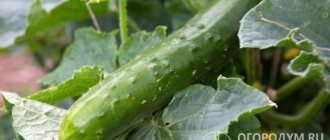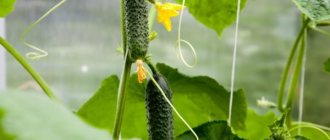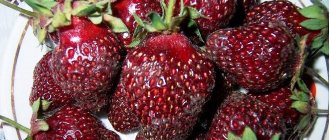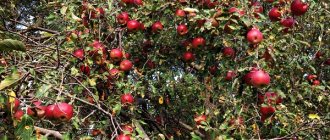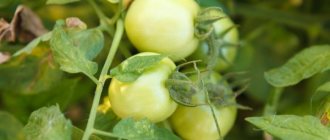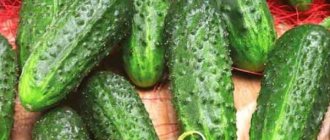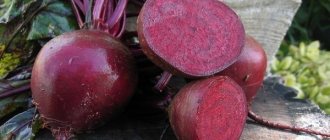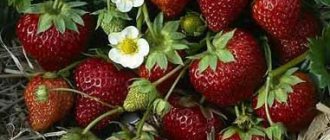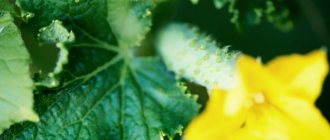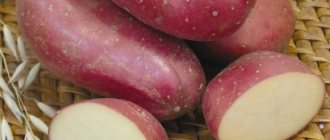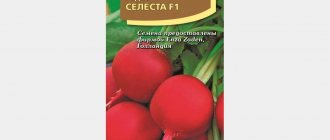One of the most popular varieties of cucumbers is the Meringue hybrid. This fact is explained by its excellent yield, attractive appearance, excellent taste and versatility. Such cucumbers can be grown in any Russian region in open soil or under film cover.
Meringue cucumber seeds
Cucumber variety "Merengue"
The cucumber variety “Merengue” has excellent yield
Description of the cucumber variety
Early ripening Merengue cucumbers were developed by Dutch breeders. This parthenocarpic species does not require pollination, so it can be grown in greenhouse conditions where there are no pollinating insects.
It takes a little more than a month for the fruits to appear after full germination. The crop actively (stablely and continuously) bears fruit throughout the entire period of growth. The seeds of the fruits do not ripen, so they do not overgrow and they do not turn yellow. The length of the fruit is from 8 to 10 cm, weight – no more than 100 grams.
Only the first generation has valuable qualities inherited from the parent variety, therefore, collecting their seeds will be useless, hence the designation of the hybrid - F1 (first generation).
The natural property of parthenocarpy in the hybrid is fixed at the genetic level, which is considered one of the most important advantages when growing a garden crop on protected soil. Read more about the features and nuances of growing parthenocarpic cucumbers here.
Growing
Cucumbers are heat-loving plants. They also respond well to irrigation and maintaining high humidity in closed ground. They like to grow in sunny places. But at the same time, good yields can be obtained in slightly shaded areas. The plantings are located after their predecessors: soybeans, peas, beans, onions, cabbage.
Preparing the soil before planting cucumber crops
The soil
The mechanical composition of the soil also affects the yield of the Meringue hybrid. Sandy loam and light loamy soils suit it best. You can independently determine the composition on your site. To do this, take a little soil, moisten it and roll it into a ball. Results:
- Sandy – the soil crumbles;
- Sandy loam - the ball rolls, but the cylinder cannot be molded;
- Loam. When you try to bend the cylinder, it cracks.
Different types of soils
In the fall, before deep loosening, fertilizers are applied to the bayonet of a vertically placed shovel: manure, humus, compost, leaf soil, peat and other organic matter at the rate of 10 kg per square meter of area. If it is not there, then you can use mineral fertilizers: potassium salt and superphosphate. And in the spring, before harrowing the site, also add ammonium nitrate. Also, humus is added to each hole before sowing.
Read about preparing the soil for cucumbers in a greenhouse in the fall here.
It often happens that there is nowhere to get organic matter in the required quantity. You will need much less of it if you pour it directly into the hole before planting.
Seeds purchased from a specialized store do not require additional processing. And if they are painted pink, green or another color, then they have been pre-treated and cannot be soaked.
Colored cucumber seeds should not be soaked.
In the open ground
When your beds are ready to plant, you need to check the soil temperature. Cucumbers are heat-loving plants and can only germinate in soil that has warmed up to 12–15 degrees.
The seed planting scheme is dotted. The distance between them is up to 10 cm, and between the rows 70. Planting depth is up to 3 cm. After the emergence of seedlings, the following measures are carried out:
- Shallow loosening;
- Break through after the appearance of the first true leaf. The distance between plants is increased to 15 cm. If sowing was in holes, then 2-3 sprouts are left;
- Feed with mullein or fermented bird droppings. This operation must be repeated two more times with an interval of 14-15 days;
It is better to fertilize cucumbers with chicken droppings.
- Regular watering. After 2–3 days, irrigation is carried out at the rate of 3 buckets of water at room temperature per square meter of area.
The hybrid grows and bears fruit better on a trellis. Therefore, you can stretch the wire, twine or cucumber net, and then tie up the plant. It is well warmed by the sun and blown by the wind, which reduces the likelihood of disease.
You cannot overfeed cucumbers with nitrogen fertilizers, because the vegetative mass will increase greatly. There will be many stepchildren. The fruits do not ripen for a long time, and nitrates will accumulate in them.
In greenhouses
The main agrotechnical measures for growing Merengo cucumbers are similar for both open ground and greenhouses. And they consist of soil preparation, planting seedlings or sowing seeds, shallow loosening, irrigation, fertilizing and pest and disease control. But it also has its own characteristic features. So, it is advisable to grow cucumbers from seedlings indoors. This will allow you to get earlier products. It is planted when the temperature in the greenhouse is around 20-22 C for several days in a row. There should be no sudden temperature changes during the growing period. It should be higher than during the adaptation period and even reach 30 degrees at the beginning of the formation of the ovary. It is necessary to adjust the temperature indicators if the plants exhibit the following signs:
- The leaves acquire a yellowish tint and begin to wither;
- Flowering stops and the flowers dry out.
Wilting of cucumber leaves due to temperature changes
The greenhouse grower must also pay attention to the air humidity in the greenhouse. When planting seedlings, this figure may not exceed 75% relative humidity. By the flowering period it is raised to 90%. And when the plant begins to lose color, it is again reduced to 70%.
A special feature of growing the plant is tying it in greenhouses to a trellis and a Pelican hanging hook. One of the main points is also the removal of side shoots up to 5 leaves. Or at a level of one and a half meters they pinch so that 3 leaves and two fruits remain. This material will tell you how to tie tomatoes in a greenhouse.
If there is no Pelican hook, then above the trellis the central stem is twisted along the last trellis wire, which can be at a height of 2 to 3.5 meters.
Scheme of forming a cucumber using the hanging method
It is necessary to regularly remove dry, damaged and dead leaves from the bushes.
Advantages and disadvantages
Hybrid Meringue, in addition to durability and growth vigor, has many other positive qualities:
- early maturity - greens appear 2 months after planting;
- no pollination required;
- open ground gives a yield of 10 kg per square meter. m, and closed - 15 kg;
- when sowing purchased seeds, a stable harvest is ensured, because only individual grains do not germinate in rare cases;
- the commercial quality of cucumbers makes them suitable not only for home consumption, but also for sale;
- During transportation, vegetables show excellent preservation;
- resistance to various diseases;
- significant benefits for humans due to its rich vitamin composition.
The only disadvantage is the annual purchase of new seeds, because they will not bear fruit.
Seed preparation
Cucumber seeds are planted at the end of April - early May, when the ground warms up to a temperature of 12-15 degrees. Before sowing, the seeds are pre-treated. This process is carried out in several stages.
- First, you need to separate the seeds suitable for sowing. To do this, dissolve a spoonful of salt in a liter of water. Seeds are placed in this solution. Those that sink to the bottom of the container are washed under running water and used for sowing. The “pacifiers” floating on the surface of the solution are disposed of.
- Before sowing, seeds are disinfected. To do this, prepare a pink solution of potassium permanganate. The seeds are soaked in it for twenty minutes. Then the seed is removed from the solution, washed under running water, and dried.
After treatment, sowing can be done. To improve the quality of the seeds, it is recommended to place them in the refrigerator for a day.
Soil requirements
Meringue cucumbers are grown in any soil with a loose structure. Good drainage and sufficient organic matter are required.
The soil should not be salty. High salt levels make it difficult to absorb liquid from the soil, plant growth decreases, greens become small, and fruits become curved. With a low salt level, the result will be the opposite, but the plant will become sensitive to various diseases. The optimal soil acidity value is 5.5-7 pH.
See the review and comparison of Meringue cucumbers:
Rules for sowing seeds and planting seedlings
Meringue cucumbers are grown using seedlings or seeds.
Direct sowing of seeds
This type of seeding is very popular and can save time and effort on growing seedlings. Features of this method:
- the sowing period in the middle zone begins in early May and ends in mid-June;
- to get an early harvest, pre-prepared seeds are sown and covered with spunbond or other high-quality material;
- you will need to sow dry seeds and seeds soaked before pecking together;
- It is more convenient to use the nest sowing method; in this case, three or four seeds are placed in one hole.
In the second ten days of May, seeds can be sown in open soil without significant shelter.
Planting seedlings
When using this method, the first harvest is accelerated and its volume is significantly increased relative to seedless sowing. Success in planting and growing seedlings can be achieved using certain subtleties:
- It is better to sort out the seeds and soak the full seeds in a solution with growth stimulants;
- sowing of soaked seeds is carried out in pots or other containers no deeper than 1.5 cm;
- Only high-grade nutritious soil intended for vegetables is used;
- soil and air humidity should be at a moderate level;
- water the seedlings as needed and only with warm water (23-25 degrees);
- Before planting (a week before), you need to harden the seedlings.
Before transferring the seedlings to open soil, it is better to water it well. Cucumber seedlings are planted between 20 and 25 days of age. In the middle zone, seedlings are planted from May 12 to 20, and in open soil without shelter - from June 3 to 15.
Features of hybrid agricultural technology
Hybrid Meringue F1 is grown in various ways:
- in a greenhouse and in open-air beds;
- sowing directly into beds or through seedlings.
The choice is determined by climatic conditions, capabilities and desires of gardeners. Yields are higher in shelters (up to 15 kg per square meter), in addition, planting seedlings in greenhouses allows you to obtain early harvests even in temperate climates.
Growing seedlings
Hybrid seeds are usually sold processed, completely ready for planting.
On a note!
Seed material is sold in bags with additional protection. The seed coat is pink, green or blue.
The timing of sowing depends on the weather conditions of the area and the approximate time of planting the seedlings in a permanent place. The age of the seedlings should be 20-25 days, based on this, sowing days are calculated.
Approximate time for sowing seedlings (in the middle zone):
- for greenhouses – April 20;
- for open ground beds - the first days of May.
Care after landing
To get a high-quality harvest, Meringue cucumbers will require good care. First of all, timely weeding and loosening of planting beds, regular watering and minor fertilizing (2-3 times throughout the entire period) are needed:
- It is better to water in the evening at the root (water temperature - 23 degrees);
- Some loosening and mulching will be required;
- weeds are regularly removed;
- to protect the crop from pests and diseases, spraying with special means is carried out;
- To feed cucumbers in open ground, it is better to use slurry, infusion of bird droppings, or complex fertilizer.
Plant care rules
The hybrid cucumber variety Meringue F1 is considered an unpretentious crop. Care will not cause trouble and will not take much time. For a good harvest, cucumber bushes must be provided with moisture, nutrients and oxygen.
Watering
Like any cultivated plant, the Meringue cucumber needs watering. The water should be warm and settled. The amount of liquid directly depends on the age of the plant itself. Before flowering, it will be enough to use 3 liters of water per square meter. During flowering, the amount of liquid is increased to 5 liters.
Soil treatment
To saturate the vegetative organs with oxygen, the soil around the stems is loosened. It is worth remembering that you need to bury garden tools carefully and not deeply, so as not to damage the lateral roots. It will be enough to simply break the earthen crust and go deeper by a maximum of 2-3 cm. During processing, the grown weeds are removed. To preserve moisture and looseness of the soil, beds with Meringue cucumbers are mulched.
Bush formation
This procedure makes it possible to increase productivity. In the axils of the leaves from the ground to a height of 60 cm, it will be necessary to remove short shoots more than 2 cm long, as well as the formed inflorescences. To a height of 1 meter, the first fruit and the lowest leaf are removed from the main stem. The bushes are tied to the trellises using a rope or a piece of fabric. The top is pinched as soon as the lashes reach a length of 1.5 meters.
Top dressing
Gardeners use natural fertilizers and minerals for the Meringue cucumber. Cucumber bushes need feeding every 7 days.
Here's what you can use:
- Prepare a solution that will consist of 20 g of urea, 10 g of potassium sulfate, 15 g of superphosphate. Dissolve all these substances in a 10 liter bucket of water.
- Crystalon cucumber. 2 g of the drug is diluted in a liter of water. 250 liters of the drug are used per 1 hectare.
- Dissolve 1 spoon of ammonium nitrate in 10 liters of water and take superphosphate in the same amount. Stir. Add 3 g iron and 2 g boric acid. For 10 square meters use 2.5 liters.
Expert opinion
Stanislav Pavlovich
Gardener with 17 years of experience and our expert
Ask a Question
Important! Nitrogenous fertilizers should be used with extreme caution. An excess of such feeding can disrupt the development of the bush, flowering and fruiting.
How to achieve a generous harvest?
When gardeners choose a certain variety of vegetables to grow, good yield is one of the main indicators. With proper care, temperature conditions and optimal air humidity, Meringue cucumbers will show high yields.
Taking into account the long growing season of Meringue, you can provide cucumbers not only for your own family, but also make a profit from it. To achieve high yields it is necessary:
- tie vines of cucumbers to trellises;
- correctly remove shoots that impede plant growth (stepchildren);
- carry out timely harvesting of fruits.
Diseases and their prevention
Meringue cucumbers are immune to powdery mildew, but are susceptible to anthracnose. It is caused by the appearance of fungus due to violations of temperature and humidity. In this case, the leaves become covered with yellow spots, and the bush may die. The disease is extremely difficult to treat, so it is easier to prevent it by using fungicides.
If there is high humidity in the greenhouse, the fruits may become covered with mucus. A plant affected by white rot is pulled out, and Bordeaux mixture is used to spray healthy bushes.
Meringue cucumbers in open ground attract spider mites. Larvae from whitefly eggs will feed on the sap. Insecticides are used to get rid of these pests.
"Meringue F1": biological description, history of selection
The hybrid is the result of the work of a subsidiary of the breeding and seed agricultural company Monsanto. The packaging may contain either the name of a large corporation or a subsidiary – Seminis. It was in the experimental plots of the latter that “Merengue F1” saw the light of day. The hybrid was included in the State Register of Breeding Achievements of the Russian Federation in 2007, simultaneously with the start of vegetable imports from Holland. Cucumber “Merengue F1” is approved for cultivation in all regions under film and in open ground.
Bushes
Plants are medium-sized with light branching. However, thanks to the good foliage of the vine, the bushes look dense. Smooth, wrinkle-free, medium-sized leaf blades are colored intensely green. Female flowering type. Pollination occurs without bees, which makes the hybrid suitable for cultivation in protected soil. Shoots have the ability to quickly regenerate: they quickly recover from damage.
Fruit
The type of formation of greens is bunched. Up to four gherkin-type fruits develop in the leaf axils. The length of greens rarely exceeds 10 cm. Diameter - 4 cm. Weight of a marketable cucumber - 80-100 g. Straight, cylindrical fruits, sometimes with a slight bend, are covered with thin skin with large tubercles, which are topped with white spines. Zelentsy, even if removed from the vine late, are not prone to overgrowth and yellowing. The pulp is aromatic, dense, creating a crunch when broken.
Harvesting and storage rules
Ripe fruits are picked every three to four days. Although they will not overgrow and turn yellow, they will deprive the newly formed cucumbers of nutrients.
The fruits can be salted or pickled. Fresh storage is possible for 2-3 weeks in a cool place.
Despite the Dutch origin of the hybrid variety of Meringue cucumbers, the Russian climate is excellent for growing this crop and achieving high yields. The growing technology is simple and accessible to all gardeners. If all its conditions are met, you can expect an excellent harvest.
0
0
Copy link
Reviews
Marina Kornienko, 52 years old
I really liked the Meringue pickles! Really sweet and juicy, with thin skin and small seeds, dense aromatic pulp without voids. They ripen quickly and amicably, so I immediately begin canning the harvest. I constantly remove gherkins and use them for pickling; I use larger fruits for pickling and salads. All cucumbers are smooth, with tubercles, non-thorny and without defects (“bulbs” or “hooks”), rich dark green color. So it looks and tastes great!
Albina Senetskaya, 47 years old
We bought expensive Dutch seeds of Meringue cucumbers from Seminis for testing. We prepared the seedlings at home, they all sprouted and then took root safely after planting in open ground, without any illnesses. They were grown on a trellis, watered and weeded whenever possible, and fertilized twice with chelated fertilizers. The harvest turned out to be plentiful, the cucumbers were delicious. I will definitely plant it next season and recommend it to everyone.
Inga Stoyanova, 37 years old
This year, several “parthenocarpics” were planted in a polycarbonate greenhouse, including “Merengue F1”. I was pleased with the taste and excellent appearance of the greens, but in terms of productivity they were inferior to “Asker” and “Marinda” and they finished bearing fruit earlier. The cucumbers were mainly sold - they do not overgrow and do not turn yellow, that is, they do not lose their marketability, and they tolerate transportation and storage well when picked. But we ourselves had enough to eat and close for the winter.
Svetlana Potekhina, 24 years old
“Merengue” disappointed me. At first, all the sprouts seemed to be strong, but then some kind of rot set in and most died. Perhaps the seeds were of poor quality (I took Kazakh ones). Those that survived had a small harvest. But the cucumbers themselves are tasty and crispy; there was no bitterness at all, even in August.
